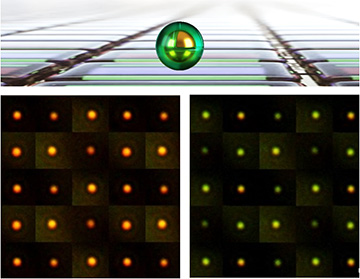
Electrochromic nanoparticle-on-mirror constructs (eNPoMs) formed from gold nanoparticles encapsulated in a conductive polymer shell. [Image: NanoPhotonics Cambridge/Hyeon-Ho Jeong, Jialong Peng]
Many species of octopus and squid rapidly alter their skin colors and patterns to camouflage themselves from both predators and prey. Scientists in the United Kingdom have developed a new type of pixel—reportedly, the smallest ever—that could make large-scale displays cheap enough to wrap around entire buildings and achieve similar color-changing effects.
The team at the University of Cambridge Nanophotonics Center devised a display surface with nanoscale pixels made of gold-and-polymer spheres atop a metallic mirror (Sci. Advances, doi: 10.1126/sciadv.aaw2205). The tiny plasmonic pixels can be tuned over a wavelength range exceeding 100 nm with a refresh rate of 50 Hz or better.
Golden nanodots
The researchers already knew that the combination of plasmonic metasurfaces and certain types of electrically conducting polymers can function as optical switches or pixels. By altering the refractive index of the polymer medium surrounding the plasmonic material, scientists can change the peak of the local surface plasmon resonance and the corresponding emitted color. However, the group faced two challenges: speeding up the slow refresh rate of these devices and ensuring that they emit in the visible instead of the infrared range.
To solve these problems, Nanophotonics Center director Jeremy Baumberg and his colleagues manufactured large quantities of “electrochromic nanoparticle-on-mirror constructs,” or eNPoMs. These tiny objects are 80-nm-wide gold spheres coated with a shell, between 11 and 20 nm thick, of a conductive polymer called polyaniline. The thickness of that polymer shell crucially determines the gap between the gold core and the planar mirror—a gold sheet supported by flexible plastic—to which they are attached by simply spraying them on. “It is hard to get nano-assembly of tiny gaps to work on roll-to-roll processes, but we found a way to use solution processing to control the gaps simply,” Baumberg says.
When voltage is applied to the mirror, the eNPoMs give off light, with shorter wavelengths emitted from the particles with thicker shells. The authors claim that their proof-of-concept display operated for more than three months at power densities below 300 μW per square centimeter (using 9 fJ of energy per pixel), which is a factor of 10 times less than the conventional e-paper of today. The display also had more than 109 pixels per inch and optical contrast of better than 50 percent.
Optimizing for efficiency
“I think this is the only sort of viable way to coat buildings,” Baumberg says. “All current display technology is active and inefficient. You need something which will stay to whatever color it is set to for a long time, to drive down the energy usage which is currently prohibitive. And it has to be produced by low-cost processes on roll to roll, which is not where most of the research community has been exploring for nanophotonics.”
For a follow-up, the Cambridge team is optimizing the blue end of the generated visible spectrum of the nanopixels and making flexible array demonstrators to show to potential partners.
